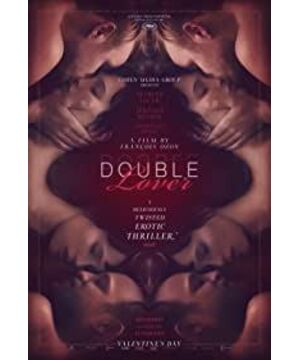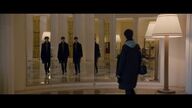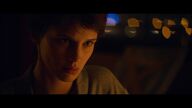Analysis of the play In fact, Ou Rong has already "spoiled" in the second conversation between the heroine and Paul. In this conversation, the heroine talks about she had a very strange dream, Paul wanted to rape her or something. And at this time, the screen is split, and two heroines appear. In this conversation, the heroine also talked about her mother, who was lying in the coffin, but she felt that it was herself in the coffin. And when the heroine was in the museum for the first time, that shot was like she was lying in a coffin. Audiovisually done well. Ou Rong's use of mirrors and glass in the film, the mirror implies division, and multiple mirror images of the heroine often appear in the film. Glass suggests space separation, and there are three broken mirrors (shattered glass) in the film. The first time was when Louis hit the heroine, she fell on the glass, the glass shattered, the sense of suspense increased, and the boundary between the real world and the fantasy world gradually became clear. The second time was when the heroine shot and set people up, the glass shattered, and the heroine's fantasy world ended. The third time is the last scene, the heroine's sister hammers the glass, the glass shatters, the movie ends, the audience's fantasy world ends, and they return to the real world. ps. I watched it at the Broadway Film Center in Hong Kong. When the movie ended, there was a folded mirror when I went down the stairs. I could see many incomplete mirror images of myself, which was quite amazing. The heroine needs to express two emotions through hallucinations, one is the insecurity from her boyfriend, which can be solved by releasing the suppressed sexual desire; the other is the guilt or fear of her sister. The first half has been talking about insecurity. The insecurities first appear when the heroine discovers Paul's old passport, which is not the same as his current name. Paul also refused to explain everything to her during the after dinner conversation. So the next day, she was in the art gallery, leaning against a white background, and a psychedelic MV-style picture appeared on the background. That was the official start of the fantasy. In the next scene, the heroine finds Louis on the bus. The heroine in Louis's place is the state of her inner desire: her mother is dead, she has a sister, and she has a cat. Basically whenever the heroine feels threatened, unsafe with Paul, she goes to Louis, or Louis will show up. This rule is more fully implemented in the first half. But Louis is not only responsible for liberating the heroine's repressed sexual desire, but also bears the hatred of her sister in the heroine's heart. For Paul, Louis does not exist, and for the heroine, the sister does not exist. The heroine's inner feelings for her sister are reflected in Louis. Sandna, who appears last, also has two roles. One is to imply that she is the sister of the heroine. In the scene where the heroine pushed the door into Sandna's room, Ou Rong did not shoot the heroine directly, but the heroine in the mirror. Sandna's tearful eye happens to be a mirror image of the heroine. The second role is to spread suspense and take on the role of Paul Louis' line in the heroine's fantasy. Ou Rong's skill is still there, and the suspense is well shot. But the second half is still a bit broken, and that reversal is not very good. In the second half, the suspense has been paved for so long, and the pavement is so full that you can show me this when you take off your pants? Moreover, the two emotions of the heroine are not well unified through this suspenseful story, which still feels bad.
View more about Double Lover reviews










